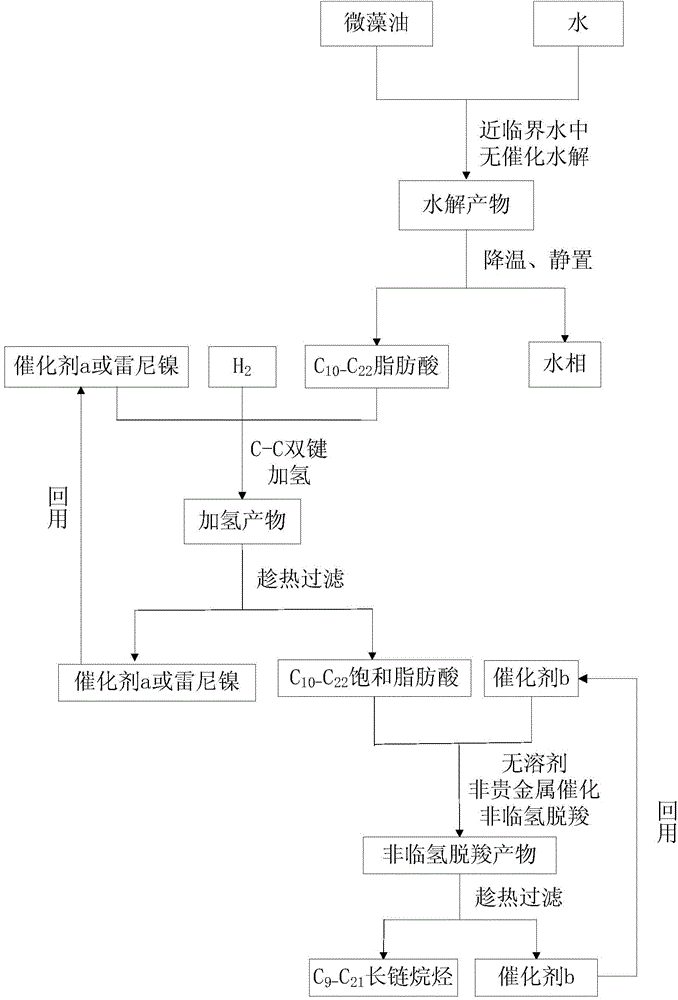Method for preparing long-chain alkane with microalg al oil as raw material in low hydrogen consumption
A long-chain alkane, microalgae oil technology, applied in chemical instruments and methods, hydrocarbons, hydrocarbons, etc., can solve problems such as inability to handle microalgae oil, and achieve the effect of reducing catalytic costs and reducing hydrogen consumption
- Summary
- Abstract
- Description
- Claims
- Application Information
AI Technical Summary
Problems solved by technology
Method used
Image
Examples
Embodiment 1
[0061] Add 150g of deionized water and 50g of dinoflagellate oil into a 500mL intermittent high-temperature and high-pressure reactor, start stirring, heat up to 220°C for hydrolysis reaction for 6h, after the hydrolysis reaction is completed, cool to room temperature, and obtain the upper hydrolyzate (C 10 ~C 22 fatty acid) 37.8g; 37.8g hydrolyzate and 1.9g 20% Cu-Cr (mass ratio 1:1) / Al 2 o 3 Add it into a 500mL intermittent high-temperature and high-pressure reactor, empty the air in the reactor, fill it with hydrogen to 7MPa, start stirring, heat up to 190°C for 2 hours, and then filter the obtained 29.6g C 10 ~C 22 Saturated fatty acids; combine 29.6g hydrogenation product and 0.6g 10%Ni / Al 2 o 3 Add it into a 500mL intermittent high-temperature and high-pressure reactor, start stirring, heat up to 350°C for 2 hours, and filter while it is hot to obtain 12.5g C 9 ~C 21 long chain alkanes.
Embodiment 2
[0063]Add 100g of deionized water and 100g of chlorella oil into a 500mL intermittent high-temperature and high-pressure reactor, start stirring, heat up to 210°C for hydrolysis reaction for 4 hours, after the hydrolysis reaction is completed, cool to room temperature, and obtain 82.5g of the upper layer hydrolyzate after the oil-water separation ; Add 82.5g of hydrolyzate and 0.8g of Raney nickel into a 500mL intermittent high-temperature and high-pressure reaction kettle, empty the air in the kettle, fill it with hydrogen to 3MPa, start stirring, and heat up to 230°C for 4 hours of hydrogenation reaction. 57.5g of C obtained by filtration 10 ~C 22 Saturated fatty acid; add 57.5g of hydrogenated product and 5.7g of 15% Fe / mesoporous silicon into a 500mL intermittent high-temperature and high-pressure reactor, start stirring, heat up to 370°C for 5 hours, and filter while hot to obtain 28.5g of C 9 ~C 21 long chain alkanes.
Embodiment 3
[0065] Add 150g of deionized water and 50g of Isochrysis oil into a 500mL intermittent high-temperature and high-pressure reactor, start stirring, and heat up to 230°C for hydrolysis reaction for 4 hours. After the hydrolysis reaction is completed, cool to room temperature, and the upper layer hydrolyzate 35.1 is obtained after oil-water separation. g; 35.1g hydrolyzate and 0.2g 15% Cu-Cr (mass ratio 1:1) / SiO 2 Add it into a 500mL intermittent high-temperature and high-pressure reaction kettle, empty the air in the kettle, fill it with hydrogen to 9MPa, start stirring, heat up to 180°C and perform hydrogenation reaction for 1 hour, then filter the obtained 26.1g C 10 ~C 22 Saturated fatty acid; add 26.1g of hydrogenated product and 3.9g of 5% Ni / MWCNTs into a 500mL intermittent high-temperature and high-pressure reactor, start stirring, heat up to 370°C for 8 hours, and filter while hot to obtain 15.3g of C 9 ~C 21 long chain alkanes.
PUM
 Login to View More
Login to View More Abstract
Description
Claims
Application Information
 Login to View More
Login to View More - R&D
- Intellectual Property
- Life Sciences
- Materials
- Tech Scout
- Unparalleled Data Quality
- Higher Quality Content
- 60% Fewer Hallucinations
Browse by: Latest US Patents, China's latest patents, Technical Efficacy Thesaurus, Application Domain, Technology Topic, Popular Technical Reports.
© 2025 PatSnap. All rights reserved.Legal|Privacy policy|Modern Slavery Act Transparency Statement|Sitemap|About US| Contact US: help@patsnap.com



